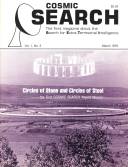![[NAAPO Logo]](../../Images/NAAPOsm.jpg) North American AstroPhysical Observatory (NAAPO)
|
|
In Review:
By: John Kraus and Mirjana Gearhart
Why is the Universe the Way It is?In a deeply perceptive article, "Fitness in the Universe: Choices and Necessities"*, philosopher-scientist and Nobel laureate George Wald of Harvard sees the remarkable in the commonplace. "We tend to take too much for granted" says Wald, "particularly when it is so fundamental that it surrounds us." In a cosmos of change where anything can happen but only some things persist, Wald asks the question, "Why?" Thus, he points out that if the proton did not have so much greater mass than the electron, all matter would be fluid and if the proton did not have exactly the same but opposite charge as the electron (or some simple multiple of it) all matter would be charged, and the universe as we know it would not exist: everything would tend to fly apart — no stars, no galaxies, no life. It is remarkable too, he notes, that the same four elements, hydrogen, carbon, nitrogen and oxygen, play equally important roles in the vital functioning of a great star as in the metabolism of a small living organism. Further, both the star and the organism are coupled by the radiation from the star which provides the energy on which the organism depends. Wald calls water (made of two of these elements: hydrogen and oxygen) "the strangest molecule in all chemistry." In its frozen form it floats and, he says, "if ice did not float — and hydrogen sulphide and ammonia ices do not float — it is highly unlikely that life could arise or long survive" because ice's floatability allows the bulk of liquid water to remain below it rather than freezing solidly during long cold spells. Evolution of living organisms on the earth has led them to certain carbon molecules for the performance of certain functions as the chlorophylls for photosynthesis and carotenoids for vision. Learning about how life evolved on the earth, Wald says, must tell us something about how it might arise elsewhere. Under the heading of individuality he notes that although every molecule of a substance is identical, no two living organisms are or ever have been identical. "Each living organism is unique, different from every other, different even from itself from moment to moment." Back to electrons and protons he asks if their properties are accidental; for although "one could tinker" a bit with their difference in mass without changing things very much, the exact equality of their charge is an extreme limitation. "Only precise equality would seem to yield the universe we know. So — as we see it — this may be the best way to build a universe. What I want to know is: How did the universe find that out? How could it have arrived at those properties in its elementary particles without trials? — and what could have been the nature of those trials?"
Did the principle of natural selection which guides the development of living organisms, asks Wald, also have a hand in determining the properties of protons and electrons? "It is a possibility worth considering," he concludes, "that God is a mathematical physicist."
— John Kraus
*In "Origins of Life", Reidel, Dortrecht-Holland, 1974, edited by Cyril Ponnamperuma.
"The Planet-Girded Suns" by Sylvia Louise Engdahl*Sylvia Engdahl writes in a clear, simple, easily-understood manner that should appeal to readers of all ages. In "The Planet-Girded Suns" she has produced an interesting, well-researched history of the idea that extraterrestrial life exists. She notes that the idea of other solar systems supporting life is not a new one. For expressing such ideas, Giordano Bruno was burned at the stake as a heretic in Rome in 1600. Almost 100 years later, as Engdahl relates, Christian Huygens published the first full-length scientific treatise on the subject. Huygens, a Dutch astronomer and physicist, wrote "The Celestial Worlds Discover'd" and was one of the first to realize how insignificant earthly problems could become when viewed with a more cosmic perspective. Engdahl notes that by the 18th century, belief in extraterrestrial life was not just the fad of a few — the belief became basic and endured relatively unchanged for almost a century. But there were doubters, such as William Whewell, Master at Cambridge's Trinity College. In his "On the Plurality of Worlds" published in 1853, he contended that there might not even be other planets orbiting other solar systems, let alone life on those planets. "The Planet-Girded Suns" is an interesting mixture of history and literature. Quotations are given from many poets, from Milton to Tennyson, who have turned their pens to the heavens, speculating both on the grandeur of the universe and whether man-like creatures inhabit other worlds. By carefully reconstructing her story from voluminous notes on many writers, both well-known and obscure, Engdahl has given vitality and dimension to the idea of extraterrestrial intelligence at a time when it is gaining renewed acceptance as both a great scientific endeavor as well as a great philosophical question.
"The Planet-Girded Suns" is entertaining and informative, providing a background for today's interpretations of an idea that has been around since the early Greeks and will be around to tantalize man for a long time.
Mirjana Gearhart
*1974, Atheneum, New York.
If extraterrestriaIs ever happen onto the Voyager records, we may likely receive a three word message: "SEND MORE BACH!"
|
